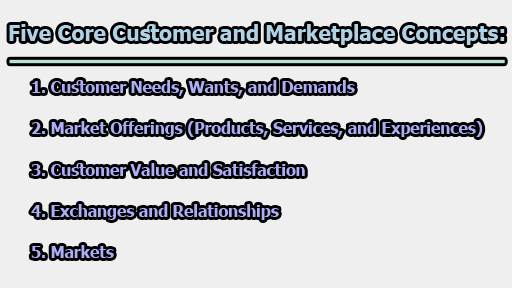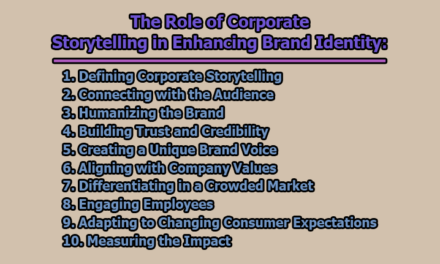Five Core Customer and Marketplace Concepts:
In the realm of marketing, a profound understanding of core customer and marketplace concepts is the foundation upon which successful strategies are built. These five fundamental pillars encompass the intricate dynamics of customer needs, market offerings, value and satisfaction, exchanges and relationships, and the very essence of markets themselves. By comprehending these concepts, marketers are empowered to tailor their efforts to the intricate tapestry of human desires and behaviors, forging connections, and crafting experiences that resonate with consumers. In this article, we will delve into the five core customer and marketplace concepts.
1. Customer Needs, Wants, and Demands:
These are fundamental aspects of understanding customers. Needs are basic human requirements, while wants are shaped by society, culture, and personality. When wants are supported by purchasing power, they become demands. Marketers must recognize and address these needs, wants, and demands to serve their customers effectively.
1.1 Customer Needs: Customer needs are the most fundamental aspect of human existence. They represent the basic requirements that people have to live, survive, and thrive. These needs can be categorized into several distinct types:
- Physical Needs: These include necessities like food, clothing, shelter, warmth, and safety. Without these, human survival is at risk. Marketers often cater to these needs by providing essential products like groceries, clothing, and home security systems.
- Social Needs: Humans are inherently social creatures, and they have a need for belonging, affection, and interaction with others. This need drives the consumption of products and services related to social connection, such as social media platforms, dating services, or even products that foster a sense of belonging, like branded merchandise that creates a community of fans.
- Individual Needs: People also have individualistic needs, which may include a desire for self-expression, personal growth, knowledge, and achievement. Marketers address these needs through products and services like self-help books, online courses, art supplies, and even personal development coaching.
1.2 Customer Wants: Wants are different from needs. They are shaped by various factors, including society, culture, and individual personality. Wants are not limited to survival or basic requirements but extend to the desires and preferences that make individuals unique. For example:
- Cultural Influence: Cultural factors play a significant role in shaping wants. For instance, in some cultures, a traditional wedding ceremony is a want that people aspire to, and the market responds with products and services related to weddings.
- Societal Trends: Changing societal trends can create new wants. The rise of eco-consciousness, for instance, has led to a greater want for sustainable and environmentally friendly products.
- Individual Preferences: People have their unique preferences and tastes. A person’s love for a specific type of music, fashion style, or hobby reflects their individual wants.
1.3 Customer Demands: Demands take the concept of wants a step further. Demands arise when wants are backed by buying power, meaning customers not only desire a product or service but are willing and able to pay for it. Understanding this transition is crucial for marketers because it indicates a clear market opportunity:
- Buying Power: To convert wants into demands, individuals must have the financial means to make a purchase. This involves having the necessary income or access to credit.
- Value and Satisfaction: For a customer to demand a product, they must believe that it will add value and satisfaction to their wants and needs. Marketers play a pivotal role in conveying this value through effective advertising, branding, and messaging.
The understanding of customer needs, wants, and demands is foundational for effective marketing. Marketers must identify and cater to these elements to develop products and services that resonate with their target audience. By recognizing the transition from wants to demands, they can create strategies to attract customers who are not only interested but also willing to pay for what they offer.
2. Market Offerings (Products, Services, and Experiences):
To fulfill customer needs and wants, businesses create market offerings. These offerings encompass not only physical products and services but also information and experiences. Marketers should focus not only on the specific product but also on the benefits and experiences it provides. Let’s break down each of these components:
- Products: Physical goods or tangible items make up a significant portion of market offerings. These can include everything from everyday consumer products like smartphones and clothing to industrial machinery and equipment. Product-based marketing often involves features, quality, design, and brand recognition.
- Services: Services are intangible offerings that fulfill specific needs or wants. They can range from professional services like legal advice, healthcare, or consulting to more everyday services like transportation, cleaning, or entertainment. Service marketing often focuses on customer experience, reliability, and the expertise of service providers.
- Information: In the information age, data and knowledge are valuable market offerings. This can include educational content, data analytics, research reports, and information products. The quality and relevance of the information provided are key factors in information marketing.
- Experiences: Experiential marketing involves creating memorable and enjoyable interactions with products or services. It’s not just about what a customer buys but how they feel during and after the experience. For example, theme parks, fine dining restaurants, and luxury travel destinations are marketed based on the unique and enjoyable experiences they offer.
2.1 Looking Beyond the Product: It’s essential for marketers to understand that successful marketing goes beyond just promoting the specific product or service. They should also consider the benefits, solutions, and experiences that the product/service provides. Here are some key points to keep in mind:
- Value Proposition: Marketers need to communicate the value of their offerings. Customers want to know how a product or service will address their needs and provide value. This involves highlighting unique selling points, benefits, and features.
- Creating Experiences: In a competitive market, creating memorable and positive customer experiences is a significant differentiator. Businesses should strive to engage customers emotionally and make the process of purchasing and using the product or service enjoyable.
- Branding and Identity: Establishing a strong brand identity is crucial. It’s not just about selling a product; it’s about selling the brand and the lifestyle it represents. Branding is the sum of perceptions, emotions, and associations that customers have with a business.
- Diversification: Companies often diversify their market offerings to meet a broader range of customer needs. For example, a software company might offer a basic free version of its software along with premium paid versions to cater to different customer segments.
- Innovation: Continuous innovation is vital to staying competitive. Products and services should evolve to meet changing customer needs and market trends.
Market offerings encompass a wide array of products, services, information, and experiences. Effective marketing involves understanding the full scope of what a business provides and communicating its value and relevance to customers. The focus should not solely be on the product itself but also on the overall customer experience and the brand’s identity and promise.
3. Customer Value and Satisfaction:
Customers evaluate products and services based on the value and satisfaction they expect to receive. Meeting or exceeding customer expectations leads to satisfaction and loyalty, while failing to do so can result in customer dissatisfaction and loss of business. Setting the right level of expectation is crucial for success.
3.1 Customer Value: Customer value refers to the perceived benefits that customers receive from a product, service, or offering in comparison to the cost or sacrifice they incur to obtain it. In essence, it’s about what the customer gains versus what they give up. Key points related to customer value include:
- Perceived Benefits: Customer value is based on the perceived benefits of a product or service, which may include functionality, quality, convenience, and emotional satisfaction.
- Cost or Sacrifice: The cost or sacrifice can be monetary, time, effort, or anything the customer gives up to acquire the offering. It’s essential to assess whether the perceived benefits outweigh these costs.
- Competitive Advantage: Companies that can consistently offer higher customer value compared to their competitors are more likely to gain a competitive advantage in the market.
3.2 Customer Satisfaction: Customer satisfaction relates to the level of contentment and happiness a customer experiences after using a product or service. Achieving customer satisfaction is vital for building and maintaining customer loyalty. Key points related to customer satisfaction include:
- Expectations: Customer satisfaction is often tied to the fulfillment of customer expectations. Meeting or exceeding these expectations leads to satisfaction, while falling short can result in dissatisfaction.
- Loyalty: Satisfied customers are more likely to become repeat buyers and brand advocates. They are more loyal and less inclined to switch to competitors.
- Word-of-Mouth: Satisfied customers are more likely to share positive feedback and recommendations with others, contributing to positive word-of-mouth marketing.
3.3 Setting the Right Level of Expectation: Marketers must carefully manage customer expectations. Setting the right level of expectation is essential to building trust and long-term relationships. Here are some considerations:
- Underpromise and Overdeliver: It’s often a good practice to underpromise and then exceed customer expectations. This creates positive surprises and enhances customer satisfaction.
- Clear Communication: Transparent and accurate communication about what the product or service can and cannot do is crucial. Overhyping or misrepresenting the offering can lead to unmet expectations.
- Consistency: Maintaining a consistent level of quality and service is essential for meeting or exceeding customer expectations over time.
Customer value and satisfaction are integral to successful marketing. Providing customers with perceived benefits that outweigh their costs and consistently meeting or exceeding their expectations lead to higher satisfaction and increased loyalty. Building and nurturing strong customer relationships requires a deep understanding of these concepts and a commitment to delivering value and ensuring customer satisfaction.
4. Exchanges and Relationships:
Marketing occurs when customers engage in exchange relationships to satisfy their needs and wants. Companies must work on building and maintaining these relationships, as retaining customers and growing business often depend on it. Consistently delivering superior value and satisfaction is essential for relationship building.
4.1 Exchanges: An exchange is at the heart of marketing. It is the process through which customers obtain a desired product or service by offering something in return, typically money. Key elements of exchanges include:
- Mutual Benefit: Exchanges are meant to be mutually beneficial. Customers receive value from the product or service they purchase, and businesses receive payment for their offerings.
- Two Parties: Exchanges involve at least two parties – the buyer (customer) and the seller (business). These parties engage in a transaction to satisfy their respective needs and wants.
- Understanding Customer Needs: Successful exchanges require a deep understanding of customer needs, preferences, and motivations. Marketers must tailor their offerings to meet these needs effectively.
4.2 Relationships: In the modern marketing landscape, building and maintaining relationships with customers is crucial. Businesses recognize that it’s often more cost-effective to retain existing customers than to acquire new ones. Key elements of relationship marketing include:
- Customer Retention: Building long-term relationships with customers can lead to higher customer retention rates. Satisfied and loyal customers are more likely to make repeat purchases and continue doing business with a company.
- Customer Lifetime Value: Understanding the long-term value of a customer is essential. A loyal customer can bring in more revenue over time than a one-time buyer.
- Customer Engagement: Engaging with customers goes beyond the initial transaction. This involves ongoing communication, feedback, and support to ensure customers remain satisfied and loyal.
- Word-of-Mouth Marketing: Satisfied customers often become brand advocates, promoting a business through word-of-mouth recommendations. This form of marketing is highly influential and cost-effective.
4.3 Building and Maintaining Relationships: To build and maintain relationships with customers, businesses should consider the following strategies:
- Personalization: Tailor marketing efforts to individual customers based on their preferences and behavior. Personalization can make customers feel valued.
- Customer Service: Provide excellent customer service, addressing concerns and inquiries promptly and effectively. Positive interactions with customer service representatives can enhance the customer experience.
- Loyalty Programs: Implement loyalty programs that reward repeat customers, encouraging them to continue doing business with the company.
- Feedback and Communication: Encourage customers to provide feedback, and actively listen to their suggestions and concerns. Use this feedback to make improvements and show customers that their opinions matter.
- Consistency: Maintain consistency in product quality, service, and messaging. Customers appreciate reliability and predictability.
The concept of exchanges and relationships underscores the importance of understanding how customers make buying decisions and how to create lasting connections with them. Successful marketing involves not only securing initial transactions but also nurturing ongoing relationships to foster customer loyalty and advocacy.
5. Markets:
A market includes all actual and potential buyers of a product or service who share a common need or want that can be satisfied through exchange relationships. The modern marketing system is not limited to an organization and its employees but also involves suppliers, competitors, and marketing intermediaries, all of which contribute to the overall value chain.
5.1 What Is a Market: A market is a space or platform where buyers and sellers come together to exchange goods, services, information, or experiences. In a broader sense, a market is not just a physical place but a group of potential and actual buyers sharing common needs or wants. Key points related to markets include:
- Actual and Potential Buyers: A market includes both the customers who are currently purchasing products or services and those who have the potential to do so in the future.
- Common Need or Want: What binds a market together is the shared need or want that can be satisfied through exchange relationships. This need could be anything from basic necessities like food to more complex desires like luxury items or entertainment.
- Interactions and Competition: In a market, businesses interact with each other and with customers, leading to competition and innovation. Markets are dynamic, with constant changes in consumer preferences, technology, and other factors.
5.2 Understanding Markets: To effectively understand and navigate markets, marketers should consider the following:
- Market Segmentation: Recognize that not all customers in a market are the same. Segment the market by identifying groups of customers with similar needs, preferences, and behaviors. This allows for more targeted marketing efforts.
- Market Research: Conduct thorough market research to gather data on customer preferences, trends, and competitive landscape. This data helps inform marketing strategies and decision-making.
- Market Dynamics: Understand that markets are constantly evolving. Economic conditions, technological advancements, and shifts in consumer behavior can impact market dynamics. Businesses need to adapt to these changes.
- Competition and Differentiation: Recognize that competition is a fundamental aspect of a market. Businesses should find ways to differentiate themselves from competitors by offering unique value, features, or customer experiences.
- Emerging Markets: Keep an eye on emerging markets where new customer needs and wants are developing. Being proactive in identifying and entering these markets can lead to growth opportunities.
- Global Markets: With the globalization of business, consider the potential of expanding into international markets. This involves understanding different cultures, regulations, and customer behaviors in various regions.
The concept of markets is at the core of marketing. A market is where buyers and sellers converge to exchange goods, services, information, or experiences. Understanding markets involves segmenting customers, conducting research, adapting to changing dynamics, and recognizing the importance of competition and differentiation. Successful marketing strategies are built on a solid understanding of the market and its components.
In conclusion, in an ever-evolving world of commerce, the five core customer and marketplace concepts underscore the essence of effective marketing. By understanding and leveraging customer needs, crafting enticing market offerings, delivering value and satisfaction, nurturing relationships, and navigating markets with insight, marketers can position themselves for success. The ability to not only meet but exceed customer expectations, to create lasting bonds, and to adapt to the changing tides of markets is at the heart of thriving in the dynamic business landscape. Embracing these concepts enables marketers to not only reach their audience but also to truly engage and empower customers in an era defined by connectivity and constant change.

Assistant Teacher at Zinzira Pir Mohammad Pilot School and College










